Potrebujeme váš súhlas na využitie jednotlivých dát, aby sa vám okrem iného mohli ukazovať informácie týkajúce sa vašich záujmov. Súhlas udelíte kliknutím na tlačidlo „OK“.
ASTM E2268-04(2011)
Standard Test Method for Water Penetration of Exterior Windows, Skylights, and Doors by Rapid Pulsed Air Pressure Difference
Automaticky preložený názov:
Štandardná skúšobná metóda pre vniknutiu vody a exteriérových Okná, svetlíky a dverí Rapid Pulzný Tlak vzduchu Rozdiel
NORMA vydaná dňa 1.11.2011
Informácie o norme:
Označenie normy: ASTM E2268-04(2011)
Poznámka: NEPLATNÁ
Dátum vydania normy: 1.11.2011
Kód tovaru: NS-44859
Počet strán: 6
Približná hmotnosť: 18 g (0.04 libier)
Krajina: Americká technická norma
Kategória: Technické normy ASTM
Kategórie - podobné normy:
Anotácia textu normy ASTM E2268-04(2011) :
Keywords:
doors, skylights, water penetration, windows, Air pressure testing--building constructions/materials, Doors/door assemblies, Performance--building materials/applications, Skylights, Water penetration--exterior windows/curtain walls/doors, ICS Number Code 91.060.50 (Doors and windows)
Doplňujúce informácie
| Significance and Use | ||||
|
This test method is a standard procedure for determining the resistance to water penetration during rapid cyclic pulses of dynamic air pressure differences. The air-pressure differences acting across a building envelope vary greatly. These factors should be fully considered prior to specifying the test pressure difference to be used. The median test pressure used in this test method is defined as the specified test pressure supplied by the user and related to the maximum positive building design pressure. This test method departs from the format of other ASTM water penetration resistance test methods based on a maximum test pressure related to a maximum positive building design pressure. As the specified or median test pressure is increased, the maximum test pressure in this procedure is also increased to 1.5 times the specification median test pressure. This higher maximum test pressure may not be representative of actual building service conditions. For this reason the maximum recommended median test pressure is 480 Pa (10 psf), which corresponds to a maximum test pressure of 720 Pa (15 psf). The pulsed pressure of this test method may act to pump water past dry seals and breather systems of units incorporating these features, thereby making the test method more severe than a static pressure test method. On the other hand, the low pressure portions of the pressure cycles of this test method may allow weep systems and drainage dams to dissipate water from units incorporating these features, thereby making the test method less severe than a static pressure test method. Note 1—In applying the results of tests by this test method, note that the performance of a wall or its components, or both, may be a function of proper installation and adjustment. In service, the performance will also depend on the rigidity of supporting construction and on the resistance of components to deterioration by various causes, (vibration, thermal expansion and contraction, and so forth). It is difficult to accurately simulate the actual complex wetting conditions that can be encountered in service, with large wind-blown water drops, increasing water drop impact pressures with increasing wind velocity and lateral or upward moving air and water. Some designs are more sensitive than others to this upward moving water. Note 2—This test does not identify unobservable liquid water which may penetrate into the test specimen. |
||||
| 1. Scope | ||||
|
1.1 This test method covers the determination of the resistance of exterior windows, skylights, and doors to water penetration when water is applied to the outdoor face and exposed edges simultaneously with a rapid pulsed air pressure at the outdoor face higher than the pressure at the indoor face. 1.2 This test method is applicable to windows, skylights, or doors alone. Those interested in testing curtain walls to rapid pulsed air pressure differences should use AAMA 501.1-94. 1.3 This test method addresses water penetration through a manufactured assembly. Water that penetrates the assembly, but does not result in a failure as defined herein, may have adverse effects on the performance of contained materials such as sealants and insulating or laminated glass. This test method does not address these issues. 1.4 The proper use of this test method requires a knowledge of the principles of pressure measurement. 1.5 The values stated in SI units are to be regarded as standard. The values given in parentheses are mathematical conversions to inch-pound units that are provided for information only and are not considered standard. 1.6 This standard does not purport to address all of the safety concerns, if any, associated with its use. It is the responsibility of the user of this standard to establish appropriate safety and health practices and determine the applicability of regulatory limitations prior to use. |
||||
| 2. Referenced Documents | ||||
|
Podobné normy:
Historická
1.11.2009
Historická
1.5.2013
Historická
1.6.2012
Historická
1.6.2012
Historická
1.6.2012
Historická
15.3.2010


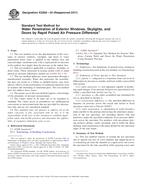
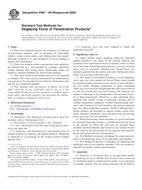 ASTM E987-88(2009)..
ASTM E987-88(2009)..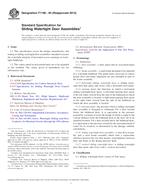 ASTM F1196-00(2013)..
ASTM F1196-00(2013)..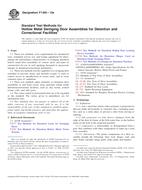 ASTM F1450-12a
ASTM F1450-12a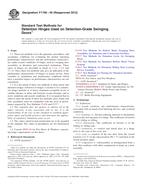 ASTM F1758-05(2012)..
ASTM F1758-05(2012)..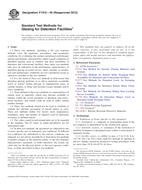 ASTM F1915-05(2012)..
ASTM F1915-05(2012)..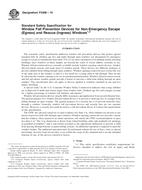 ASTM F2006-10
ASTM F2006-10
 Cookies
Cookies
